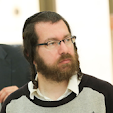Week two and a half in Israel -
Week two and a half in Israel and my third (observed) Shabbat here, and the view sure looks good. This Shabbat my yeshiva went up to the Golan Heights up in the north to have a Shabbaton, which is like doing something out of the norm for Shabbat, although there is no such thing as an ordinary Shabbat. Just to give a quick prelude about the Golan Heights, they were not originally part of the State of Israel in 1948, but were part of the Historic Land of Israel. During the Six Day War of 1967 against Syrian, Jordanian, and Egyptian forces, Israel captured the Golan Heights from Syria, strategically important for security reasons. The other reason it was important is because it belongs to us. I digress, you see, the Syrians occupied the Golan Heights before 1967 and they were using it to terrorize Israeli kibbutzim in the north (my parents lived on one of the fartherst north kibbutzim in Israel, Kibbutz Kfar Blum). This was possible because the Golan Heights give anyone who occupies it a fascinating and looming standpoint over a huge chunk of the countryside, giving them much military strategery. In 1967 Israel captured this area of land and since the nations have recognized it as "disputed territory." Today, during the day, we stood on a hill facing north, about an half an hour walk up hill from the moshav that took us in, towards Mt. Hermon, Israel's highest mountain and near the border with Syria, and in between the Kinneret (Sea of Galilee) and Israel's eastern-most border. The ability to envision, as if a map, exactly where in Israel we were standing was quite astounding.
It was here where our tour guide told us a bit about Eli Cohen, the Israeli spy that managed to infiltrate Syria to the point where he became best friends with its Defense Minister, some twenty years ago. Eli Cohen was born in Egypt, therefore he was an Arabic-speaking Jew, but honed his craft speaking the Syrian dialect of Arabic, which as those who know something about Arabic know that the dialects are rather varied. He also worked on the nuances of the language, which can be said to be as different as southern English and California English. Being on such good terms with the Syrian Defense Minster, Cohen was able to freely enter his office and look over plans, which he photographed and sent to the Israeli government. The Syrians, prior to 1967, had thought of a way to deliver a devastating blow to Israel; the source of the Kinneret, Israel's primary water source, was a river in Syria (which then included the Golan Heights). The plan of the Syrians was to dig a huge trench, about 87 miles long, in order to deflect the natural flow of the river leading into the Kinneret and therefore to choke Israel of its primary water source. Having done that (destroying its own landscape irreparably in order to destroy Israel) its war plans would have been easier. Cohen regularly sent copies of this plan to the Israeli government and when the plan was in action, Israel barraged the area and destroyed it. The Syrians were in utter shock and Cohen basically played a huge role in ensuring Israel's survival.
Cohen's place in the World to Come, G-d willing, was awesome, but his fate in this world wasn't as cheerful; he was caught by the Syrians, whom used a Russian device to track the radio signals of suspected spies, and Cohen was tortured brutally until he was hanged in Syria. His body was never returned. We stood right at the base of the trenches that the Syrian government had built to deflect the flow of the Kinneret. There is book named "Our Man in Damascus" about Eli Cohen, about twenty years old, which I hope to read, and a movie as well.
Another fascinating thing was seeing the two 1,400 year old synagogues, one of which we prayed Mincha in (afternoon services). The second one had no ceiling, since it had fallen thousands of years ago, and therefore we were provided with a view overlooking one of the giant valleys in the Golan Heights. Other than the Basalt walls and grass growing as the floor, one could make out the primary features of the synagogue easily, such as the Bima, the surface on which the Torah is placed and read. To be davining Mincha in this 1,400 year-old synagogue up in the Golan Heights, much more, was simply astounding.
I will post pictures of this trip soon.
Sunday, November 12, 2006
Subscribe to:
Post Comments (Atom)

No comments:
Post a Comment